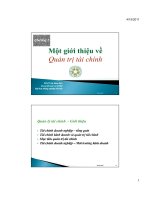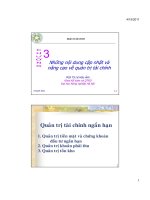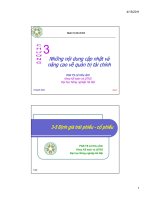ĐÁP ÁN SÁCH QUẢN TRỊ TÀI CHÍNH CUỐN TO DÀY uel KINH TE LUAT 17
Bạn đang xem bản rút gọn của tài liệu. Xem và tải ngay bản đầy đủ của tài liệu tại đây (757.81 KB, 15 trang )
Chapter 17
Financial Planning and Forecasting
Learning Objectives
After reading this chapter, students should be able to:
Briefly explain the following terms: mission statement, corporate scope, corporate objectives,
corporate strategies, operating plans, and financial plans.
Discuss the importance of sales forecasts in the financial planning process.
Calculate additional funds needed (AFN), using both the equation and projected financial
statement methods.
Identify the key determinants of external funds requirements, and make excess capacity
adjustments to both the AFN equation and projected financial statement methods.
Use regression to improve financial forecasts, and explain when this provides a better forecast.
Use ratios to modify accounts receivable or inventories in the forecasting process, and explain
when one might use this technique.
Chapter 17: Financial Planning and Forecasting
Learning Objectives 197
Lecture Suggestions
In Chapter 4, we looked at where the firm has been and where it is now—its current strengths and
weaknesses. Now, in Chapter 17, we look at where it is projected to go in the future.
What we cover, and the way we cover it, can be seen by scanning the slides and Integrated
Case solution for Chapter 17, which appears at the end of this chapter solution. For other suggestions
about the lecture, please see the “Lecture Suggestions” in Chapter 2, where we describe how we
conduct our classes.
DAYS ON CHAPTER: 3 OF 58 DAYS (50-minute periods)
198 Lecture Suggestions
Chapter 17: Financial Planning and Forecasting
Answers to End-of-Chapter Questions
17-1 The need for external financing depends on 5 key factors:
1. Sales growth (S). Rapidly growing companies require large increases in assets, other
things held constant.
2. Capital intensity (A*/S0). The amount of assets required per dollar of sales, the capital
intensity ratio, has a major effect on capital requirements. Companies with high assetsto-sales ratios require more assets for a given increase in sales, hence have a greater need
for external financing.
3. Spontaneous liabilities-to-sales ratio (L*/S0). Companies that spontaneously generate a
large amount of funds from accounts payable and accruals have a reduced need for
external financing.
4. Profit margin (M). The higher the profit margin, the larger the net income available to
support increases in assets, hence the lower the need for external financing.
5. Retention ratio (RR). Companies that retain a high percentage of their earnings rather
than paying them out as dividends generate more retained earnings and thus need less
external financing.
17-2 False. At low growth rates, internal financing will take care of the firm’s needs.
17-3 False. The use of computerized planning models is increasing because of the information
they provide.
17-4 Accounts payable, accrued wages, and accrued taxes increase spontaneously with sales.
Retained earnings increase, but only to the extent that dividends paid do not equal 100% of
net income and the profit margin is positive.
17-5 a. +.
b. -. The firm needs less manufacturing facilities, raw materials, and work in process.
c. +. It reduces spontaneous funds; however, it may eventually increase retained earnings.
d. +.
e. +.
Chapter 17: Financial Planning and Forecasting
Answers and Solutions 199
f. Probably +. This should stimulate sales, so it may be offset in part by increased profits.
g. 0.
h. +.
200 Answers and Solutions
Chapter 17: Financial Planning and Forecasting
Solutions to End-of-Chapter Problems
17-1 AFN = (A*/S0)S – (L*/S0)S – MS1(RR)
=
$3,000,000
$1,000,000
$5,000,000
–
$500,000
$1,000,000
$5,000,000
– 0.05($6,000,000)(0.3)
= (0.6)($1,000,000) – (0.1)($1,000,000) – ($300,000)(0.3)
= $600,000 – $100,000 – $90,000
= $410,000.
17-2 AFN =
$4,000,000
(0.3)
$5,000,000 $1,000,000 (0.1)($1,000,000) ($300,000)
= (0.8)($1,000,000) – $100,000 – $90,000
= $800,000 – $190,000
= $610,000.
The capital intensity ratio is measured as A*/S0. This firm’s capital intensity ratio is higher
than that of the firm in Problem 17-1; therefore, this firm is more capital intensive—it would
require a large increase in total assets to support the increase in sales.
17-3 AFN = (0.6)($1,000,000) – (0.1)($1,000,000) – 0.05($6,000,000)(1)
= $600,000 – $100,000 – $300,000
= $200,000.
Under this scenario the company would have a higher level of retained earnings, which
would reduce the amount of additional funds needed.
17-4 a.
Sales
Oper. costs
EBIT
Interest
EBT
Taxes (40%)
Net income
2005
$700
500
$200
40
$160
64
$ 96
Chapter 17: Financial Planning and Forecasting
Forecast Basis
1.25
0.70 Sales
2006
$875.00
612.50
$262.50
40.00
$222.50
89.00
$133.50
Answers and Solutions 201
Dividends (33.33%)
Addit. to R/E
$ 32
$ 64
$ 44.50
$ 89.00
b. Dividends = ($44.50 – $32.00)/$32.00 = 39.06%.
17-5 Sales = $5,000,000,000; FA = $1,700,000,000; FA are operated at 90% capacity.
a. Full capacity sales = $5,000,000,000/0.90 = $5,555,555,556.
b. Target FA/S ratio = $1,700,000,000/$5,555,555,556 = 30.6%.
c. Sales increase 12%; FA = ?
S1 = $5,000,000,000 1.12 = $5,600,000,000.
No increase in FA up to $5,555,555,556.
FA
= 0.306 ($5,600,000,000 – $5,555,555,556)
= 0.306 ($44,444,444)
= $13,600,000.
17-6 Sales = $300,000,000; gSales = 12%; Inv. = $25 + 0.125(Sales).
S1 = $300,000,000 1.12 = $336,000,000.
Inv. = $25 + 0.125($336)
= $67 million.
Sales/Inv. = $336,000,000/$67,000,000 5.0149 = 5.01.
17-7
Actual
Pro Forma
Sales
Oper. costs excluding depreciation
EBITDA
Depreciation
202 Answers and Solutions
$3,000
2,450
$ 550
250
Forecast
1.10
0.80 Sales
1.10
$3,300
2,640
$ 660
275
Chapter 17: Financial Planning and Forecasting
Basis
EBIT
Interest
EBT
Taxes (40%)
Net income
17-8 a.
Total liabilitie
s
andequity
$ 300
125
$ 175
70
$ 105
$ 385
125
$ 260
104
$ 156
= Accounts payable + Long-term debt + Common stock + Retained
earnings
$1,200,000 = $375,000 + Long-term debt + $425,000 + $295,000
Long-term debt = $105,000.
Total debt = Accounts payable + Long-term debt
= $375,000 + $105,000 = $480,000.
Alternatively,
Total debt = Total liabilities and equity – Common stock – Retained earnings
= $1,200,000 – $425,000 – $295,000 = $480,000.
b. Assets/Sales (A*/S0) = $1,200,000/$2,500,000 = 48%.
L*/Sales (L*/S0) = $375,000/$2,500,000 = 15%.
2006 Sales = (1.25)($2,500,000) = $3,125,000.
S = $3,125,000 – $2,500,000 = $625,000.
AFN
= (A*/S0)(S) – (L*/S0)(S) – MS1(RR) – New common stock
= (0.48)($625,000) – (0.15)($625,000) – (0.06)($3,125,000)(0.6) – $75,000
= $300,000 – $93,750 – $112,500 – $75,000 = $18,750.
Alternatively, using the percent of sales method:
Total assets
2005
$1,200,000
Current liabilities
Long-term debt
$ 375,000
105,000
Forecast
Basis
Additions (New
2006
2006 Sales Financing, R/E) Pro Forma
0.48
$1,500,000
Chapter 17: Financial Planning and Forecasting
0.15
$ 468,750
105,000
Answers and Solutions 203
Total debt
$ 480,000
Common stock
425,000
Retained earnings
295,000
Total common equity$ 720,000
Total liabilities and equity$1,200,000
75,000*
112,500**
AFN = New long-term debt =
$ 573,750
500,000
407,500
$ 907,500
$1,481,250
$
18,750
*Given in problem that firm will sell new common stock = $75,000.
**PM = 6%; RR = 60%; NI2006 = $2,500,000 1.25 0.06 = $187,500.
Addition to RE = NI RR = $187,500 0.6 = $112,500.
17-9 S2005 = $2,000,000; A2005 = $1,500,000; CL2005 = $500,000; NP2005 = $200,000; A/P2005 =
$200,000; Accrued liabilities2005 = $100,000; A*/S0 = 0.75; PM = 5%; RR = 40%; S?
AFN = (A*/S0)S – (L*/S0)S – MS1(RR)
$0 = (0.75)S –
$300,000
S
$2,000,000
– (0.05)(S1)(0.4)
$0 = (0.75)S – (0.15)S – (0.02)S1
$0 = (0.6)S – (0.02)S1
$0 = 0.6(S1 – S0) – (0.02)S1
$0 = 0.6(S1 – $2,000,000) – (0.02)S1
$0 = 0.6S1 – $1,200,000 – 0.02S1
$1,200,000 = 0.58S1
$2,068,965.52
= S1.
Sales can increase by $2,068,965.52 – $2,000,000 = $68,965.52 without additional funds
being needed.
17-10 Sales = $320,000,000; gSales = 12%; Rec. = $9.25 + 0.07(Sales).
S1 = $320,000,000 1.12 = $358,400,000.
Rec. = $9.25 + 0.07($358.4)
= $34.338 million.
DSO = Rec./(Sales/365)
204 Answers and Solutions
Chapter 17: Financial Planning and Forecasting
= $34,338,000/($358,400,000/365)
= 34.97 days 35 days.
17-11 Sales = $110,000,000; gSales = 5%; Inv. = $9 + 0.0875(Sales).
S1 = $110,000,000 1.05 = $115,500,000.
Inv. = $9 + 0.0875($115.5)
= $19.10625 million.
Sales/Inv.
= $115,500,000/$19,106,250
= 6.0451.
17-12 a. Sales = $2,000,000,000; FA = $600,000,000; FA are operated at 80% capacity.
Full capacity sales
= Actual sales/(% of capacity at which FA are operated)
= $2,000,000,000/0.80
= $2,500,000,000.
b. Target FA/Sales ratio = $600,000,000/$2,500,000,000
= 0.24 = 24.0%.
c. Sales increase 30%; FA = ?
S1 = $2,000,000,000 1.30 = $2,600,000,000.
No increase in FA up to $2,500,000,000.
FA
= 0.24 ($2,600,000,000 $2,500,000,000)
= 0.24 $100,000,000
= $24,000,000.
Chapter 17: Financial Planning and Forecasting
Answers and Solutions 205
17-13 a.
Morrissey Technologies Inc.
Pro Forma Income Statement
December 31, 2006
Sales
Operating Costs
EBIT
Interest
EBT
Taxes (40%)
Net income
2005
$3,600,000
3,279,720
$ 320,280
20,280
$ 300,000
120,000
$ 180,000
Forecast
2006
Basis
Pro Forma
1.10
$3,960,000
0.9110 (Sales) 3,607,692
$ 352,308
20,280
$ 332,028
132,811
$ 199,217
Dividends: $1.08 100,000 =
Addition to RE:
$ 108,000
$ 72,000
$ 112,000*
$ 87,217
*2006 Dividends = $1.12 100,000 = $112,000.
Morrissey Technologies Inc.
Pro Forma Balance Statement
December 31, 2006
2005
Cash
$ 180,000
Receivables
360,000
Inventories
720,000
Total current assets $1,260,000
Fixed assets
1,440,000
Total assets
$2,700,000
Accounts payable
$ 360,000
Notes payable
156,000
Accrued liab.
180,000
Total current liabilities$ 696,000
Common stock
1,800,000
Retained earnings
204,000
Total liab. and equity$2,700,000
206 Answers and Solutions
Forecast
Basis
Additions (New
2006
2006 Sales Financing, R/E) Pro Forma
0.05
$ 198,000
0.10
396,000
0.20
792,000
$1,386,000
0.40
1,584,000
$2,970,000
0.10
0.05
87,217*
$ 396,000
156,000
198,000
$ 750,000
1,800,000
291,217
$2,841,217
Chapter 17: Financial Planning and Forecasting
AFN =
$ 128,783
*See income statement.
b.
AFN= $2,700,000/$3,600,000(Sales) – ($360,000 + $180,000)/$3,600,000(Sales)
– (0.05)($3,600,000 + Sales)0.4
$0 = 0.75(Sales) – 0.15(Sales) – 0.02(Sales) – $72,000
$0 = 0.58(Sales) – $72,000
$72,000
= 0.58(Sales)
Sales = $124,138.
Growth rate in sales =
17-14 a.
Sales
$124,138
=
= 3.45%.
$3,600,000 $3,600,000
Currentsales
Full
capacity= % of capacityat which
sales
FA wereoperated
% increase =
=
Newsales Oldsales
Oldsales
$36,000
0.75
=
= $48,000.
$48,000 $36,000
=
$36,000
0.33 = 33%.
Therefore, sales could expand by 33% before the firm would need to add fixed assets.
b.
Krogh Lumber
Pro Forma Income Statement
December 31, 2006
(Thousands of Dollars)
Sales
Operating costs
EBIT
Interest
EBT
Taxes (40%)
Net income
2005
$36,000
30,783
$ 5,217
1,017
$ 4,200
1,680
$ 2,520
Chapter 17: Financial Planning and Forecasting
Forecast
2006
Basis
Pro Forma
1.25
$45,000
0.8551 (Sales) 38,479
$ 6,521
1,017
$ 5,504
2,202
$ 3,302
Answers and Solutions 207
Dividends (60%)
Addition to RE
$ 1,512
$ 1,008
$ 1,981
$ 1,321
Krogh Lumber
Pro Forma Balance Sheet
December 31, 2006
(Thousands of Dollars)
Cash
Receivables
Inventories
Total current asset
Net fixed assets
Total assets
2005
$ 1,800
10,800
12,600
$25,200
21,600
$46,800
Forecast
2006
Basis
1st
2006 SalesAdditions Pass
0.05
$ 2,250
0.30
13,500
0.35
15,750
$31,500
21,600*
$53,100
Accounts payable
$ 7,200
0.20
$ 9,000
Notes payable
3,472
3,472
Accrued liab.
2,520
0.07
3,150
Total current liabilities$13,192
$15,622
Mortgage bonds
5,000
5,000
Common stock
2,000
2,000
Retained earnings
26,608
1,321** 27,929
Total liabilities and equity$46,800
$50,551
AFN =
2006
2nd
AFN
Pass
$ 2,250
13,500
15,750
$31,500
21,600
$53,100
$ 9,000
+2,549
6,021
3,150
$18,171
5,000
2,000
27,929
$53,100
$ 2,549
*From Part a we know that sales can increase by 33% before additions to fixed assets are
needed. So no new assets will be needed.
**See income statement.
208 Answers and Solutions
Chapter 17: Financial Planning and Forecasting
Comprehensive/Spreadsheet Problem
Note to Instructors:
The solution for 17-14 is provided at the back of the text; however, the solution to 17-13 is
not. Instructors can access the Excel file on the textbook’s Web site or the Instructor’s
Resource CD.
17-15 Problem 17-13 reworked:
a.
Morrissey Technologies Inc.'s 2005 financial statements are shown here.
Chapter 17: Financial Planning and Forecasting
Integrated Case 209
b.
Problem 17-14 reworked:
a.
Therefore, sales could expand by 33% before the firm would need to add fixed assets.
210 Integrated Case
Chapter 17: Financial Planning and Forecasting
b.
Krogh Lumber's 2005 financial statements are shown here.
*From part a we know that sales can increase by 33% before additions to fixed assets are
needed. So no new assets will be needed.
Chapter 17: Financial Planning and Forecasting
Integrated Case 211









